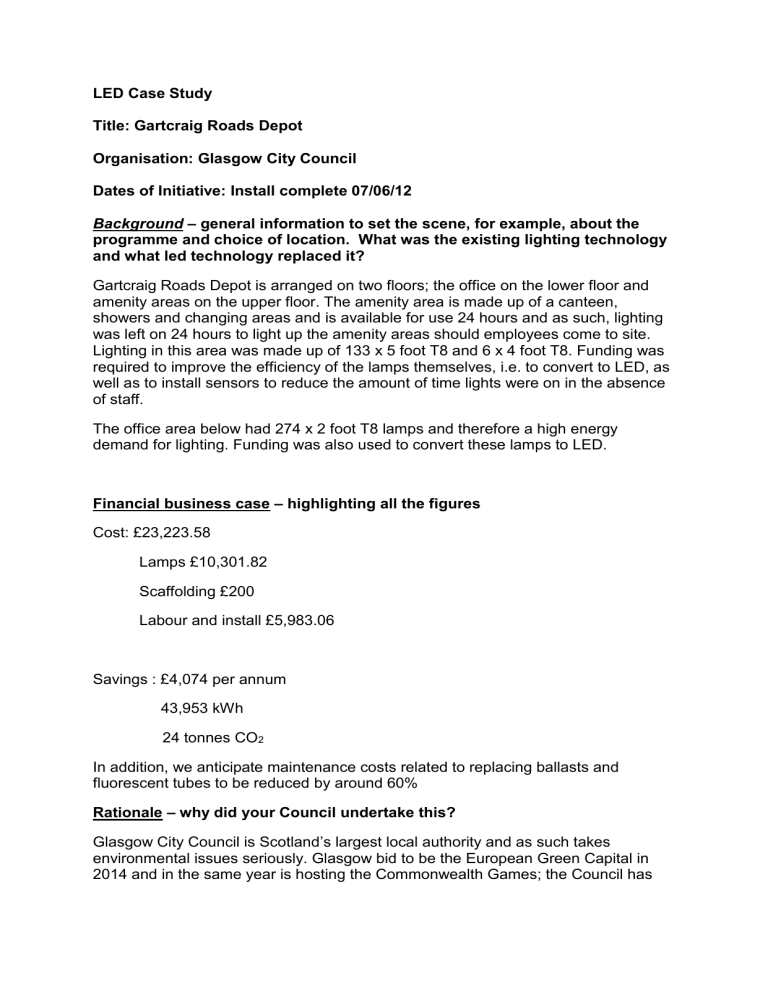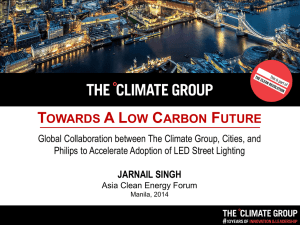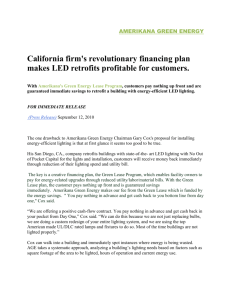LED Lighting Projects - Keep Scotland Beautiful

LED Case Study
Title: Gartcraig Roads Depot
Organisation: Glasgow City Council
Dates of Initiative: Install complete 07/06/12
Background – general information to set the scene, for example, about the programme and choice of location. What was the existing lighting technology and what led technology replaced it?
Gartcraig Roads Depot is arranged on two floors; the office on the lower floor and amenity areas on the upper floor. The amenity area is made up of a canteen, showers and changing areas and is available for use 24 hours and as such, lighting was left on 24 hours to light up the amenity areas should employees come to site.
Lighting in this area was made up of 133 x 5 foot T8 and 6 x 4 foot T8. Funding was required to improve the efficiency of the lamps themselves, i.e. to convert to LED, as well as to install sensors to reduce the amount of time lights were on in the absence of staff.
The office area below had 274 x 2 foot T8 lamps and therefore a high energy demand for lighting. Funding was also used to convert these lamps to LED.
Financial business case – highlighting all the figures
Cost: £23,223.58
Lamps £10,301.82
Scaffolding £200
Labour and install £5,983.06
Savings : £4,074 per annum
43,953 kWh
24 tonnes CO
2
In addition, we anticipate maintenance costs related to replacing ballasts and fluorescent tubes to be reduced by around 60%
Rationale
– why did your Council undertake this?
Glasgow City Council is Scotland ’s largest local authority and as such takes environmental issues seriously. Glasgow bid to be the European Green Capital in
2014 and in the same year is hosting the Commonwealth Games; the Council has
taken these opportunities to lead by example by promoting sustainable development practices across the estate.
Glasgow City Council has other drivers for environmental improvements, namely the
Carbon Reduction Commitment (CRC) and our internal Carbon Management Plan
(CMP).
The CRC is a legal obligation that requires us to pay £12/tonne of CO
2
emitted which as acted as catalyst to drive energy efficiency projects.
The CMP outlines Glasgow City Council’s commitment to reducing its carbon footprint with the aim being to deliver a 20% reduction in carbon emissions by 2013 with the aspiration of meeting the Scottish Governments 2020 and 2050 targets.
Improving our building efficiency is one of the main ways we can reduce our emissions and with lighting accounting for around 30% of the electrical load, it is one of our priority areas.
Process – what led to this good practice? What steps were followed in order to establish and continue this good practice? What are the key elements of this good practice (include different stages, activities undertaken, etc.)? were there any implications on columns or any private wire which need to be addressed before the pilot became fully operational?
The site was identified during a rolling program of site audits
– half hourly data for both electricity and gas revealed the site had a high baseload and significant out of hours consumption. When compared to CIBSE benchmark figures, the site was well above standard figures for electricity in a depot.
The site audit revealed a number of issues, primarily in relation to the lighting.
Consumption figures were calculated based on the types of lamps, their numbers and the operational times at the site. This information was sent to our maintenance team to be priced for LED conversion with motion sensors. Based on this installation cost, the business case made sense in both carbon and financial terms.
Resources required
– what human and financial resources were needed, and who was involved (both in order to set up and continue this activity)?
The energy audit was undertaken and the project managed by an Energy Officer at
Glasgow City Council.
Support was required by the site manager at Gartcraig.
There was significant input from the director of the lighting manufacturer.
The site was re-audited and the installation managed by a manager at City Building
Glasgow. Another member of their team was involved in liaising with the Energy
Officer.
Engagement with lighting supplier, to ensure our specifications would be met.
A team of electricians from City Building Glasgow installed the equipment over a period of two weeks.
Facilitating factors
– what factors enabled this activity to happen?
Without support from the manager and staff at the depot, this project would not have gone ahead.
The willingness from all involved in the project to try something new was a key factor in ensuring this project went ahead. Despite the relatively high capital costs, the benefits of this were recognised and the end result has been very well received.
Challenges overcome – what challenges, if any, did you have to overcome?
Addition time and effort went into this project for a number of reasons. New technology, new supplier, a multi-occupancy and multi-function site all meant we had to ensure everything had been factored in and laison between all parties was key to that. However, having this installation in place with minimal disruption to the site has given us confidence for future LED installations.
Results observed
– what results were observed? This may be at community level, among staff, for the organisation, etc.
The staff seem very happy with the installation, everything appears fresher and brighter and there is a certain amount of pride at the site that they are one of the first to have received this ‘new’ type of lighting.
Benefits Gained – could be significant maintenance benefits with LED lighting or better colour rendering which improves CCTV images, environmental benefits etc.
A contact at the service has said the quality of light has improved and it looks brighter. There is reduced flicker compared to the old fluorescent lights (with magnetic ballasts).
Carbon, energy and financial savings – expected and observed
We expected to see energy savings of 43,953kWh of electricity per annum as well as carbon savings of 24 tonnes.
Comparing 07/06/13 – 19/06/12 to the same period in the previous year, there has been a 22% reduction in electricity consumption at the site as well as CO
2
savings of
0.8 tonnes. There is not yet enough data to extrapolate to a year with any accuracy.
Lessons learned – what worked particularly well? What would you do differently next time? What advice would you give to staff in other organisations wishing to try an LED programme? Did the LED technology deliver the benefits anticipated - what were these? Can they be replicated?
What worked particularly well?
–
Engaging with whole supply chain and building positive working relationships as well as learning how the different organisaions operate
What would you do differently next time? – Work more closely with suppliers from the outset as we only came together when problems arose
What advice would you give to staff in other organisations wishing to try an
LED programme? To engage with all stakeholders from the outset. Fully explain the technology and allay any fears of LEDs being ‘too bright’. The additional benefits should also be highlighted at the outset.
Reduced flicker
Reduced maintenance cycles (50,000hr life versus 20,000hr life) and they don’t require other consumables such as ballasts
3-5yr warrantee (supplier dependant)
Less degradation of light over lamp life
Instantaneous switch-on, making them more suited to motion sensors
Reduced heat creation meaning they can be touched when ‘on’
LEDs are not considered ‘Special Waste’ since they don’t contain mercury and are therefore cheaper to dispose of
Similarly, LEDs tend to more robust meaning they’re more difficult to break
Like Fluorescents, LEDs come in a range of colour temperatures, from warm white to bright white, as well as in a range of colours
Available in a range of bulb sizes for most applications from spotlights to street lighting
LEDs don’t produce light in the UV spectrum making them ideal for paintings and artefact display (for use in Glasgow Life)
Did the LED technology deliver the benefits anticipated - what were these? –
Yes. Better quality of light onsite and potential energy savings (yet to be fully quantified as install was recent).
Next Steps - what are your plans to build on this pilot? How will it affect the roll out of LED lighting in your Local Authority area?
During this process we have learned a lot about the specification we would look for in other buildings in the future. It has forced us to work closely with various organisations along the supply chain which has been beneficial to all. This has led to a closer working relationship with suppliers to negotiate on price to roll out further projects.
LED lighting is a technology we will be rolling out to as many applicable sites as possible over the coming years. We will attempt to do this in three ways.
1. Specification for new build premises to include LEDs as standard – Funding would be used to supplement the additional cost this would represent compared with installing fluorescent lighting.
2. Specification for retrofit premises to include LEDs as standard
– Funding would be used to supplement the additional cost this would represent compared with installing fluorescent lighting.
3. LEDs be specified and procured as part of a planned and managed maintenance programme. This would allow fluorescent lighting to be replaced at the end of their useful life. The added benefit would be that new fluorescent tubes aren’t being installed at a time we’re replacing them elsewhere in the estate.
Reaction - what was the reaction from the local community? If the reaction was negative, how was this mitigated?
There is no community access to the site however Elected Members will be visiting the site in the coming weeks.
Additional information
– please offer your contact details or other avenue of further information.
Andrew Mouat
Principal Officer of Carbon Management
0141 287 8346 andrew.mouat@glasgow.gov.uk







